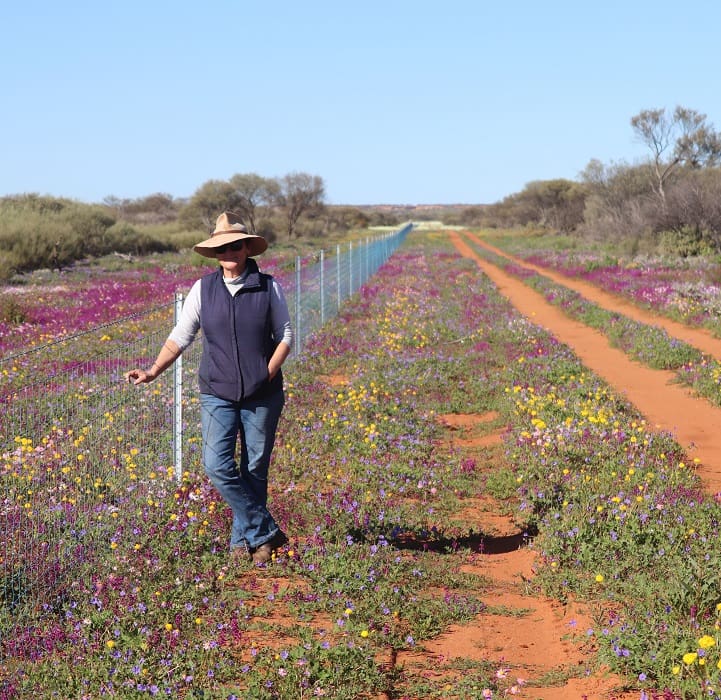
Western Australian producer Debbie Dowden has explored the motivations and challenges in removing wild dogs from cell-fenced areas.
MANAGING wild dogs is not easy work with community engagement and is not just about the deployment of tools into the landscape by the people whose assets are threatened by incursions.
According to Western Australian landholder Debbie Dowden, it requires human action, which means working within the complex dynamics of human nature.
“All of this must occur within a community that has probably experienced severe psychological trauma because of wild dog predation on their stock,” Mrs Dowden said.
Her thesis, “Wild dogs, fences and people in the Southern Rangelands of Western Australia” has explored lessons learnt from the Rangelands Cell Fencing Program to assist individuals or organisations considering building a wild dog exclusion cell fence.
The thesis undertaken for a Master of Environmental Science (Research) at the University of New England was supported by the Centre for Invasive Species and the Department of Primary Industries and Regional Development, WA.
The focus of her study was the 7.5 million hectare Murchison Regional Vermin Cell completed in December 2021.
The success of the project depends upon the ability of landholders and licenced pest management technicians to eradicate wild dogs from within the cell so stakeholders can return to running sheep and goats.
Mrs Dowden explored the motivations and challenges associated with removing wild dogs from the cell fenced areas.
She said the lessons learnt from the Murchison Regional Vermin Cell project would inform stakeholders planning other future cell initiatives.
Her study found behavioural science can help with designing practical interventions for invasive species management.
“Improving landholder participation by removing barriers to that participation and implementing strategies to strengthen drivers can be supported by behavioural science,” Mrs Dowden said.
“This research studies landholder motivations for participating in the cell fence project and examines the barriers and drivers behind human behaviour that will determine the success of the fence as a wild dog control tool.”
Mrs Dowden said community action began when a group of people share a vision and they, as a community, build a shared commitment to take collective action.
“Narratives are essential for groups because they increase understanding and empathy and connect people into groups from which collective action can grow.
“Once a pest is established and widespread, the approach to management is based on reducing the impact of the pest on private and public assets,” she said.
“This requires effective citizen-based action with a nationally consistent best-practice approach, and the National Wild Dog Plan was cited as an example.”
Mrs Dowden said the intervention needed to be delivered via a good communications strategy that selects appropriate message framing and debunks misinformation.
She said message tailoring, promoting social norms and promoting a good neighbour message were among the intervention strategies.
“The biosecurity groups could deploy appropriate interventions by celebrating the closing of the fence as a new beginning for the region and strongly promoting a shift in biosecurity action.
“Holding community training sessions for landholders who require upskilling or training would target people new to the industry or lacking confidence using tools.”
Mrs Dowden said interventions could include increasing the availability of resources and providing information and training on the most time-effective methods of wild dog control.
“Subsidies or incentives could result in greater voluntary participation in the short term.
“Furthermore, developing socially or culturally acceptable solutions and framing them so it is consistent with social values could encourage some more landholders to engage.”
Mrs Dowden said landholders with a high economic dependence on their properties could be promoted as producer demonstration sites, allowing them to share their information with others.
“Economic modelling based on running livestock, particularly given the high value of sheep and goats, and tailored to a specific property would provide information so landholders can make an informed decision about the economic benefits they may gain by conducting more wild dog control.”
The study found with the support of experts with a deeper understanding of behavioural science, it may be possible for biosecurity groups to engage some of the less motivated stakeholders to increase their level of wild dog control within exclusion cells.
“Understanding how human behaviour can affect the projects is not a panacea but having a deeper understanding of it in the context of wild dog management can have a positive impact on this and future projects,” Mrs Dowden said.

HAVE YOUR SAY